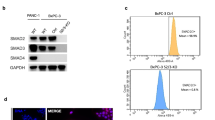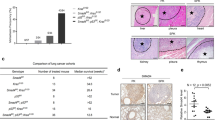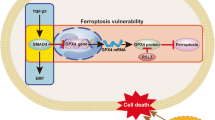Abstract
SMAD4 is a critical cofactor in signal transduction pathways activated in response to transforming growth factor-beta (TGF-β)-related ligands, regulating cell growth and differentiation. The roles played by SMAD4 inactivation in tumours highlighted it as a tumour-suppressor gene. However, restoration of the TGF-β antiproliferative pathway following SMAD4 gene transfer in null-tumour cell lines is controversial. Herein, we report the inhibitory effects of SMAD4 on pancreatic tumour invasion and angiogenesis. Adenoviral transfer of this gene in a panel of SMAD4 homozygous-deleted human pancreatic tumour cell lines restored SMAD4 protein expression and function. Although it did not affect proliferation significantly in vitro, SMAD4 inhibited in vivo tumour growth in immunodeficient mice. In this xenograft setting, differential suppression of tumour growth in vivo was mediated, at least in part, through downregulation of vascular endothelial growth factor and expression of gelatinases. We documented the reduced invasion and angiogenesis histologically and by intravital microscopy, and gained mechanistic insight at the messenger and protein level. Finally, we found a negative reciprocal regulation between SMAD4 and ETS-1. ETS-1 is considered a marker for tumour invasion. Upon SMAD4 deletion, we detected high expression levels of ETS-1 in pancreatic tumour cells, suggesting the shift of the pancreatic tumour toward an invasive phenotype.
This is a preview of subscription content, access via your institution
Access options
Subscribe to this journal
Receive 50 print issues and online access
$259.00 per year
only $5.18 per issue
Buy this article
- Purchase on Springer Link
- Instant access to full article PDF
Prices may be subject to local taxes which are calculated during checkout





Similar content being viewed by others
References
Attiga FA, Fernandez PM, Weeraratna AT, Manyak MJ and Patierno SR . (2000). Cancer Res., 60, 4629–4637.
Behrens P, Rothe M, Florin A, Wellmann A and Wernert N . (2001). Int. J. Mol. Med., 8, 149–154.
Bergers G, Brekken R, McMahon G, Vu TH, Itoh T, Tamaki K, Tanzawa K, Thorpe P, Itohara S, Werb Z and Hanahan D . (2000). Nat. Cell Biol., 2, 737–744.
Bramhall SR . (1997). Int. J. Pancreatol., 21, 1–12.
Calonge MJ and Massague J . (1999). J. Biol. Chem., 274, 33637–33643.
Dai JL, Bansal RK and Kern SE . (1999a). Proc. Natl. Acad. Sci. USA, 96, 1427–1432.
Dai JL, Schutte M, Bansal RK, Wilentz RE, Sugar AY and Kern SE . (1999b). Mol. Carcinog., 26, 37–43.
Davidson B, Reich R, Goldberg I, Gotlieb WH, Kopolovic J, Berner A, Ben-Baruch G, Bryne M and Nesland JM . (2001). Clin. Cancer Res., 7, 551–557.
Duda DG, Sunamura M, Lozonschi L, Kodama T, Egawa S, Matsumoto G, Shimamura H, Shibuya K, Takeda K and Matsuno S . (2000). Cancer Res., 60, 1111–1116.
Elvert G, Kappel A, Heidenreich R, Englmeier U, Lanz S, Acker T, Rauter M, Sieweke M, Breier G and Flamme I . (2003). J. Biol. Chem., 278, 7520–7530.
Eskinazi R, Resibois A, Svoboda M, Peny MO, Adler M, Robberecht P and Van Laethem JL . (1998). Gastroenterology, 114, 1211–1120.
Fink SP, Swinler SE, Lutterbaugh JD, Massague J, Thiagalingam S, Kinzler KW, Vogelstein B, Willson JK and Markowitz S . (2001). Cancer Res., 61, 256–260.
Friess H, Yamanaka Y, Buchler M, Ebert M, Beger HG, Gold LI and Korc M . (1993). Gastroenterology, 105, 1846–1856.
Fukushige S, Furukawa T, Satoh K, Sunamura M, Kobari M, Koizumi M and Horii A . (1998). Cancer Res., 58, 4222–4226.
Furukawa T, Duguid WP, Rosenberg L, Viallet J, Galloway DA and Tsao MS . (1996). Am. J. Pathol., 148, 1763–1770.
Inoue H, Furukawa T, Sunamura M, Takeda K, Matsuno S and Horii A . (2001). Genes Chromosomes Cancer, 31, 295–299.
Ito T, Nakayama T, Ito M, Naito S, Kanematsu T and Sekine I . (1998). Mod. Pathol., 11, 209–215.
Itoh T, Tanioka M, Yoshida H, Yoshioka T, Nishimoto H and Itohara S . (1998). Cancer Res., 58, 1048–1051.
Iwasaka C, Tanaka K, Abe M and Sato Y . (1996). J. Cell. Physiol., 169, 522–531.
Jiang Y, Liang H, Guo W, Kottickal LV and Nagarajan L . (2000). Blood, 95, 3945–3950.
Jiao S, Cheng L, Wolff JA and Yang NS . (1993). Biotechnology (N Y), 11, 497–502.
Kita D, Takino T, Nakada M, Takahashi T, Yamashita J and Sato H . (2001). Cancer Res., 61, 7985–7991.
Kondo E, Horii A and Fukushige S . (1999). J. Biochem. (Tokyo), 125, 818–825.
Lagna G, Hata A, Hemmati-Brivanlou A and Massague J . (1996). Nature, 383, 832–836.
Lefter LP, Furukawa T, Sunamura M, Duda DG, Takeda K, Kotobuki N, Oshimura M, Matsuno S and Horii A . (2002). Genes Chromosomes Cancer, 34, 234–242.
Nakayama T, Ito M, Ohtsuru A, Naito S and Sekine I . (2001). Mod. Pathol., 14, 415–422.
Nelson AR, Fingleton B, Rothenberg ML and Matrisian LM . (2000). J. Clin. Oncol., 18, 1135–1149.
Nishikawa A, Iwasaki M, Akutagawa N, Manase K, Yamashita S, Endo T and Kudo R . (2000). Gynecol. Oncol., 79, 256–263.
Oh SP, Seki T, Goss KA, Imamura T, Yi Y, Donahoe PK, Li L, Miyazono K, ten Dijke P, Kim S and Li E . (2000). Proc. Natl. Acad. Sci. USA, 97, 2626–2631.
Peng B, Fleming JB, Breslin T, Grau AM, Fojioka S, Abbruzzese JL, Evans DB, Ayers D, Wathen K, Wu T, Robertson KD and Chiao PJ . (2002). Clin. Cancer Res., 8, 3628–3638.
Ramachandra M, Atencio I, Rahman A, Vaillancourt M, Zou A, Avanzini J, Wills K, Bookstein R and Shabram P . (2002). Cancer Res., 62, 6045–6051.
Reisdorff J, En-Nia A, Stefanidis I, Floege J, Lovett DH and Mertens PR . (2002). J. Am. Soc. Nephrol., 13, 1568–1578.
Sato Y, Teruyama K, Nakano T, Oda N, Abe M, Tanaka K and Iwasaka-Yagi C . (2001). Ann. NY Acad. Sci., 947, 117–123.
Schwarte-Waldhoff I, Volpert OV, Bouck NP, Sipos B, Hahn SA, Klein-Scory S, Luttges J, Kloppel G, Graeven U, Eilert-Micus C, Hintelmann A and Schmiegel W . (2000). Proc. Natl. Acad. Sci. USA, 97, 9624–9629.
Span PN, Manders P, Heuvel JJ, Thomas CM, Bosch RR, Beex LV and Sweep CG . (2002). Oncogene, 21, 8506–8509.
St Croix B, Rago C, Velculescu V, Traverso G, Romans KE, Montgomery E, Lal A, Riggins GJ, Lengauer C, Vogelstein B and Kinzler KW . (2000). Science, 289, 1197–1202.
Sun C, Yamato T, Furukawa T, Ohnishi Y, Kijima H and Horii A . (2001). Oncol. Rep., 8, 89–92.
Sun Y, Wenger L, Rutter JL, Brinckerhoff CE and Cheung HS . (1999). J. Biol. Chem., 274, 11535–11540.
Takaku K, Oshima M, Miyoshi H, Matsui M, Seldin MF and Taketo MM . (1998). Cell, 92, 645–656.
Taniguchi N, Miyoshi E, Ko JH, Ikeda Y and Ihara Y . (1999). Biochim. Biophys. Acta., 1455, 287–300.
Teruyama K, Abe M, Nakano T, Iwasaka-Yagi C, Takahashi S, Yamada S and Sato Y . (2001). J. Cell Physiol., 188, 243–252.
Thant AA, Sein TT, Liu E, Machida K, Kikkawa F, Koike T, Seiki M, Matsuda S and Hamaguchi M . (1999). Oncogene, 18, 6555–6563.
Valter MM, Hugel A, Huang HJ, Cavenee WK, Wiestler OD, Pietsch T and Wernert N . (1999). Cancer Res., 59, 5608–5614.
Vlaykova T, Muhonen T, Hahka-Kemppinen M, Pyrhonen S and Jekunen A . (1997). Int. J. Cancer, 74, 326–329.
Vu TH, Shipley JM, Bergers G, Berger JE, Helms JA, Hanahan D, Shapiro SD, Senior RM and Werb Z . (1998). Cell, 93, 411–422.
Wilentz RE, Iacobuzio-Donahue CA, Argani P, McCarthy DM, Parsons JL, Yeo CJ, Kern SE and Hruban RH . (2000). Cancer Res., 60, 2002–2006.
Yang X, Castilla LH, Xu X, Li C, Gotay J, Weinstein M, Liu PP and Deng CX . (1999). Development, 126, 1571–1580.
Yatsuoka T, Sunamura M, Furukawa T, Fukushige S, Yokoyama T, Inoue H, Shibuya K, Takeda K, Matsuno S and Horii A . (2000). Am. J. Gastroenterol., 95, 2080–2085.
Acknowledgements
This work was supported in part by two grants-in-aid for scientific research (14657277) from the Japanese Ministry of Education, Culture, Sports, Science and Technology and grants-in-aid for cancer research from the Ministry of Health, Labour and Welfare of Japan. We thank Drs Kohei Miyazono (Department of Biochemistry, The Cancer Institute, Tokyo, Japan) and Yasufumi Sato (Department of Vascular Biology, Institute of Development, Aging and Cancer, Tohoku University, Sendai, Japan) for supplying the adenoviral constructs. We are grateful to Emiko Shibuya, Hiroko Fujimura, and Keiko Inabe at Tohoku University School of Medicine (Sendai, Japan) for their expert technical assistance.
Author information
Authors and Affiliations
Corresponding author
Supplementary information
Rights and permissions
About this article
Cite this article
Duda, D., Sunamura, M., Lefter, L. et al. Restoration of SMAD4 by gene therapy reverses the invasive phenotype in pancreatic adenocarcinoma cells. Oncogene 22, 6857–6864 (2003). https://doi.org/10.1038/sj.onc.1206751
Received:
Revised:
Accepted:
Published:
Issue Date:
DOI: https://doi.org/10.1038/sj.onc.1206751
Keywords
This article is cited by
-
miR-509-5p and miR-1243 increase the sensitivity to gemcitabine by inhibiting epithelial-mesenchymal transition in pancreatic cancer
Scientific Reports (2017)
-
SMAD4 and its role in pancreatic cancer
Tumor Biology (2015)
-
Reduced expression of bone morphogenetic protein receptor IA in pancreatic cancer is associated with a poor prognosis
British Journal of Cancer (2013)
-
Transcriptional silencing of ETS-1 efficiently suppresses angiogenesis of pancreatic cancer
Cancer Gene Therapy (2009)
-
The PMAIP1 Gene on Chromosome 18 is a Candidate Tumor Suppressor Gene in Human Pancreatic Cancer
Digestive Diseases and Sciences (2008)



